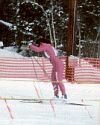Junior Nationals: Powering the Team
March 20, 2013Waxing On
Ski waxing can sometimes seem a bit mystical, and perhaps nowhere more so than Junior Nationals. From a competitor’s perspective, they select their skis the day before the race, clean the bases, if needed, and then turn them into the wax techs. Roughly 30 minutes before their race, they get back their skis all tuned for the race. What happens in between, and in fact, leading up to, is all a mystery to most.
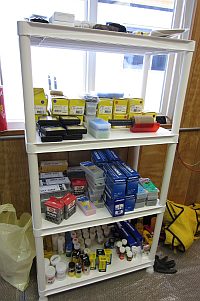 Getting to the point of applying wax to the skis is actually a culmination of a process started months before the first race. It all starts with the selection of the waxing team. This year’s team included: James Kyes (head glidewax), Igor Badamsin (head kickwax), Brian Abery, and Andrew Poffenberger. While Poffenberger was the apprentice, Abery, Badamshin and Kyes are all well seasoned Junior National veterans. One of their first jobs is the selection and stocking of supplies for the trip. Depending on regional weather and timing, the amount spent on wax alone can vary, ranging upwards of $5,000 or more. This year, due to a typically drier, colder snow, as well as a smaller budget, the team ended up spending roughly $3,000 on wax supplies. This augments an existing stockpile of waxes the team carries forward from each season. The coaches all coordinate in waxing equipment like benches and wax irons, each contributing what they can to fill the team needs. And then getting all that equipment to the race site can be a real challenge.
Getting to the point of applying wax to the skis is actually a culmination of a process started months before the first race. It all starts with the selection of the waxing team. This year’s team included: James Kyes (head glidewax), Igor Badamsin (head kickwax), Brian Abery, and Andrew Poffenberger. While Poffenberger was the apprentice, Abery, Badamshin and Kyes are all well seasoned Junior National veterans. One of their first jobs is the selection and stocking of supplies for the trip. Depending on regional weather and timing, the amount spent on wax alone can vary, ranging upwards of $5,000 or more. This year, due to a typically drier, colder snow, as well as a smaller budget, the team ended up spending roughly $3,000 on wax supplies. This augments an existing stockpile of waxes the team carries forward from each season. The coaches all coordinate in waxing equipment like benches and wax irons, each contributing what they can to fill the team needs. And then getting all that equipment to the race site can be a real challenge.
Once the team has arrived, the wax techs pretty much hit the ground running, scrambling that first day to get the wax trailer prepared. This year, there were six wax benches, roughly 10 waxing irons, and nearly two dozen brushes, as part of the supplies. The wax coaches also frequently have their own flight of test skis. Kyes brought six pairs of matching skate skis, as well as another three pairs of classic skis (in some years, they have had as many as 14 skate and 10 classic skis, mainly to cover a wider range of structure). A master wax tech owns a set of test skis like a top chef has a selection of knives.
With the wax trailer set up, the team gets down to the process of evaluating waxes. Over the course of the first few days, everything is tested -- there is no favorite brand, they all get evaluated. Kyes explained that what generally happens is one brand seems to perform consistently well across their product line, but that top brand has frequently been different from year to year. The team will spend as much as 10 hours on-site, each day, testing different combinations of waxes and structure.
The actual process of evaluating the performance is in itself an art. Kyes, and most of the top wax techs, have developed an innate ability to feel the ski speed, what Kyes describes as the breakaway and top end speeds of the wax and ski combination. Experience, and comparison with other team members, have honed this Jedi-like skill to be quite accurate. This skill allows them to quickly evaluate large sets of waxes and sets them apart from the more casual waxer.
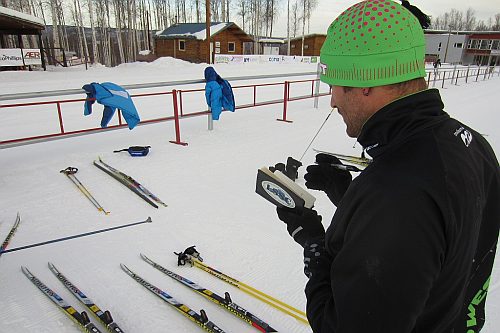 A constant companion of Kyes is his famous little black book. This book contains daily notes on weather, air and snow temperature, snow structure, etc. And there are entries for every wax and ski combination, noting the testing results. The book has data going back at least three years. Most of the entries in the book are in code, which is also how the team shares information over the open radio waves of the handheld radio sets. (Though once in awhile, when the communications aren’t working so well, the actual product name may get shouted out -- “TK 72!”).
A constant companion of Kyes is his famous little black book. This book contains daily notes on weather, air and snow temperature, snow structure, etc. And there are entries for every wax and ski combination, noting the testing results. The book has data going back at least three years. Most of the entries in the book are in code, which is also how the team shares information over the open radio waves of the handheld radio sets. (Though once in awhile, when the communications aren’t working so well, the actual product name may get shouted out -- “TK 72!”).
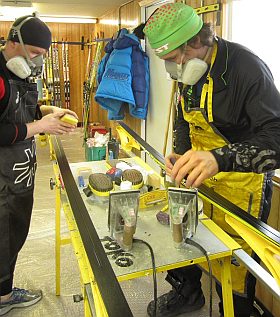 As race day approaches, the glide wax gets dialed in to a subset of the top performing waxes. However, the team will frequently pull in additional waxes for re-evaluation each day, in part to see if something is suddenly working better, and partly to verify that the current selection is still the best. The day before the race, Kyes makes the call on the race glide wax and the team members begin the long process of waxing nearly 50 pairs of racing skis. While there are normally 4-5 wax techs most days, those times when the entire fleet needs to be waxed will bring a call for all-hands on deck with the other coaches joining to help out.
As race day approaches, the glide wax gets dialed in to a subset of the top performing waxes. However, the team will frequently pull in additional waxes for re-evaluation each day, in part to see if something is suddenly working better, and partly to verify that the current selection is still the best. The day before the race, Kyes makes the call on the race glide wax and the team members begin the long process of waxing nearly 50 pairs of racing skis. While there are normally 4-5 wax techs most days, those times when the entire fleet needs to be waxed will bring a call for all-hands on deck with the other coaches joining to help out.
On race day, the wax techs are up on the hill early, again testing wax performance to ensure what they have selected is still a top choice. If need be, they will rewax the entire set of skis (though it never came to this). They also evaluate and select block waxes (fluro) for a final coat. This block is applied shortly before each race start. On some of the short events, there may be a liquid top coat that is applied trail side. While the glide wax selection generally held well through a day’s set of races, the block selection was changed with the temperatures/conditions.
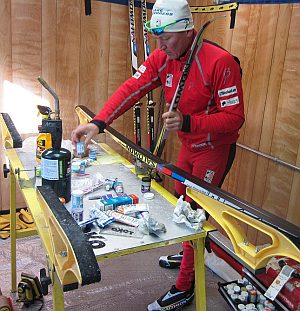 While 3-4 techs are involved in the glide wax testing, there is a single man responsible for the kick wax selection. Igor Badamshin is the kick wax guru, performing all of the kick wax testing. Badamshin will typically ski upwards of 50 kilometers each day in the process of testing a huge variety of hard kick waxes and klister. His experience is unparalleled, coming from years on the World Cup circuit as well as Olympic competition, and later as wax technician. He could be seen regularly out on the course, even during races, testing and re-testing kick waxes to ensure the skiers always had the best choice in their pocket.
While 3-4 techs are involved in the glide wax testing, there is a single man responsible for the kick wax selection. Igor Badamshin is the kick wax guru, performing all of the kick wax testing. Badamshin will typically ski upwards of 50 kilometers each day in the process of testing a huge variety of hard kick waxes and klister. His experience is unparalleled, coming from years on the World Cup circuit as well as Olympic competition, and later as wax technician. He could be seen regularly out on the course, even during races, testing and re-testing kick waxes to ensure the skiers always had the best choice in their pocket.
The costs involved in each pair of skis, per race, is hard to put an exact figure on. Over 10 vials of fluoro powder were applied, adding up to more than $1000, and at least six liquid bottles were consumed ($600), And those were just top coats, and don’t include the materials used in all of the wax testing. Toss in glide and kick wax and you’re approaching costs that can reach close to triple digits per pair of skis.
All of this work - the testing, the layers of application, and the cost of materials, don’t mean much if the skis don’t perform. And the truth is, the structure and fit of the ski still plays a big role in the performance of the glide and kick. If the skier has a poor set of equipment, the wax techs can only do so much to improve the performance. In some cases, the wax techs even pulled bad performing skis and found better equipment within their own supply, or by borrowing skis from other racers.
So how did it all go? By all indicators, the wax selections each and every race were near or at the top of the heap. In the sprint races, Kyes felt the Midwest skis weren’t performing up to his standards. However, after the event was over, one of the top team’s wax techs came over to congratulate Kyes on having the fastest skis that day.
And what did they use? Kyes described the conditions for Junior Nationals to be a dry, rounded/transformed snow crystal (mainly from the grooming), and that the snow generally skied warmer than temperatures indicated. The SkiGo brand was consistently good in these conditions, as well as Rex powders. While there wasn’t specific information on kick wax selections, it was evident skiers had good kick in the classical races.
Fuel
While the Midwest wax team kept the skiers equipment fast, someone had to keep the skiers themselves fueled up and ready to race. Doug Durfey was the new Midwest chef this year, tasked with all the duties involved in keeping a group of more than 60 fed with three meals a day for over a week.
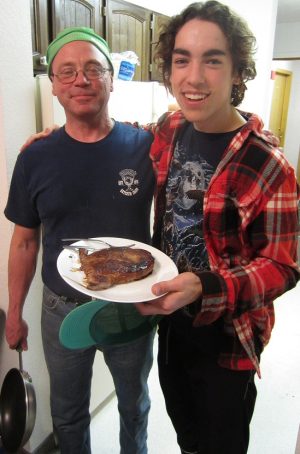 Durfey was an off-season acquisition, discovered via his relationship with Igor Badamshin, as well as former CXC head coach Bryan Fish and trip leader Bill Pierce. Durfey was the former team chef for Intermountain, and has cooked for many of the top US skiers including Simi Hamilton, Caitlin Gregg, as well as a number of celebrities including Lindsay Vonn. He has been cooking for ski teams for at least seven years, and literally cooking since his teenage years. When not cooking for the Midwest team, Durfey is preparing meals for the Sun Valley Ski Academy, in Ketchum, Idaho.
Durfey was an off-season acquisition, discovered via his relationship with Igor Badamshin, as well as former CXC head coach Bryan Fish and trip leader Bill Pierce. Durfey was the former team chef for Intermountain, and has cooked for many of the top US skiers including Simi Hamilton, Caitlin Gregg, as well as a number of celebrities including Lindsay Vonn. He has been cooking for ski teams for at least seven years, and literally cooking since his teenage years. When not cooking for the Midwest team, Durfey is preparing meals for the Sun Valley Ski Academy, in Ketchum, Idaho.
Durfey’s day had little downtime. Starting typically by 4 am to prepare breakfast, with just a hour or two break between that and lunch, then a similar break between lunch and supper. Those “breaks” usually involved planning and purchases for upcoming meals. Fortunately, Durfey was helped by the ever present assistant Claire.
The amount of food prepared for each meal is staggering. A typical breakfast of scrambled eggs, pancakes, and oatmeal required 15 dozen eggs, over 300 pancakes cooked, and roughly 25 lbs of cooked oatmeal. Some of the dry goods and bulk products were purchased via delivery service, all of the fresh produce like fruits and vegetables, along with meat and poultry were hand selected and produced by Durfey. Everything was cooked from scratch, using mainly utensils that Durfey brought himself. This included a small skillet in which he cooked all of the scrambled egg batches.
With over 60 mouths to feed, there comes a few special needs relating to dietary restrictions, all of which Durfey gladly worked with the skiers and coaches to ensure everyone’s needs were met. He believes strongly about the quality of the food he prepares, and that the skiers must feel good about the meals and be well fed.
One of Durfey’s traditions wherever he has cooked is to prepare a special meal for skiers that medal. When Ian Torchia won the J1 boys freestyle title, he asked for and received a wonderful steak dinner. Alayna Sonnesyn and the relay girls, enchiladas; Jan Ketterson, a pork chop meal; Ben Saxton had two meals, a big burger and a plate of ribs (the night before he won the classical title!)

